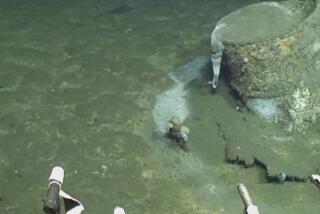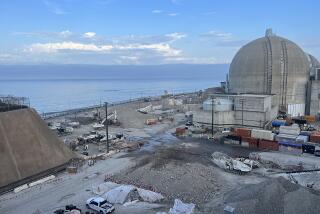Tons of Plutonium Are Stored Unsafely, U.S. Says
- Share via
WASHINGTON — The Energy Department is storing tons of plutonium in unsafe plastic containers and other packages, some of which are bulging from pressurized hydrogen gas that has accumulated as radioactive plutonium deteriorates, a senior department official said Tuesday.
The containers, located at Lawrence Livermore National Laboratory near San Francisco and other sites across the nation, are at risk of bursting and contaminating workers with cancer-causing plutonium, Assistant Energy Secretary Tara O’Toole said.
Energy officials said Tuesday the agency has begun an immediate program to replace all of the suspect plastic containers within 12 months. Newly designed containers would be good for an estimated 50 years, by which time the agency hopes to find a permanent way to dispose of the plutonium.
The containers--which include ordinary food cans--are part of a broad safety and environmental problem posed by the nation’s inventory of 26 metric tons of plutonium, left from four decades of nuclear bomb production.
Although awareness of plutonium safety risks has increased gradually over the last three years, a massive 26-volume assessment released Tuesday by the Energy Department provides significant new evidence that conditions are more serious than was previously thought, according to government and private experts.
“Overall, the department’s inventory of plutonium presents significant hazards to workers, the public and environment and little progress has been made to aggressively address the problem,” according to an Energy Department report.
The report found hazards at nearly every major site in the nuclear weapons complex, identifying 299 specific environmental, health and safety problems. “Buildings and equipment that are aging, poorly maintained or of obsolete design contribute to the overall problem,” the report noted.
“It is a more serious problem than we knew of before,” said Daryl Kimball, associate director at Physicians for Social Responsibility, a watchdog group on nuclear issues. “Some of these facilities are an accident waiting to happen.”
The report found that the most serious problems exist at the Rocky Flats plant near Denver, which has 12.8 metric tons of plutonium stored in 10 buildings with serious fire, ventilation, and industrial equipment problems.
The report ranked its other “most vulnerable” sites in descending order as Savannah River, S.C.; Hanford, Wash.; Los Alamos, N.M., and Livermore.
When the Cold War ended, bomb output was abruptly cut off and the normal movement of plutonium in the production process came to a halt. As a result, plutonium was left in various containers that were never intended for long-term storage, O’Toole said.
The most serious risks are those posed by 400,000 liters of plutonium stored in liquid form, which can leak or become concentrated enough to set off a nuclear chain reaction. Plutonium powders, oxides and ashes also pose serious storage problems because they are unstable, corrosive and can burn spontaneously.
Among the containers used to store plutonium are plastic bottles, plastic bags, cardboard cartons, metal drums and even food cans, the report said.
The Energy Department has 8.7 metric tons of its plutonium inventory stored in the form of scraps or residues in 34,000 various packages, of which 300 are located at Livermore.
The report noted that eight plutonium packages at Livermore had recently swelled because of hydrogen gas buildup caused by radioactive decay and moisture buildup.
More to Read
Sign up for Essential California
The most important California stories and recommendations in your inbox every morning.
You may occasionally receive promotional content from the Los Angeles Times.












